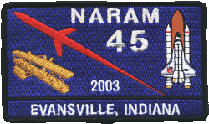National Association of Rocketry Annual Meet
|
|
NARAM 45 National Association of Rocketry Annual Meet |
|
Peanut Sport Scale Clarification
Pink Book rule 53.2.3 defines the size restrictions of Peanut Sport Scale. It states that the model must be no more than 30 centimeters in overall length or no more than 2 centimeters in body diameter.
In an attempt to provide additional information about the size restrictions, the National Contest Board has issued the following. The 2 centimeter maximum diameter for Peanut Sport Scale will be the largest AIRFRAME diameter necessary to build a sport scale model. Items such as interstage clamps, fairings, strap-on boosters, launch lugs, antennae, fin cans. and the like will be considered as detailing. The 2 centimeter maximum can be either a payload section (such as but not limited to Trailblazer-II, Delta, Ariane, Titan-III), or the largest rocket body diameter of multistaged rockets (such as but not limited to Argo/Javelin, RAM-B, Nike-Cajun, Aerobee).
Since there are many other types of "non-circular" rockets that can be modeled, it will be almost impossible to cite the maximum diameter for each individual one. Better judgment on the part of the modeler AND judges will necessitate what can and cannot be entered as a Peanut Sport Scale. One example of these would be the Space Shuttle (Energia-Buran), either with or without booster. In the case of including the booster, the maximum diameter would be the external tank. If entering the Shuttle alone, the maximum diameter would be measured at the vertical and horizontal body at the center (wings, tail, engine fairings would be considered detailing). For the Atlas, the main rocket body would be the maximum diameter, the two side engine fairings and conduits would be detailing. The exception would be if the payload body was the widest diameter. For conical shaped rockets such as the Russian N-1 or Apollo-LES, the maximum diameter would be measured at its base.
With so many possibilities, all prototypes could not be discussed. Use your better judgment, OR ASK!
More tips on the way...
 |
 |